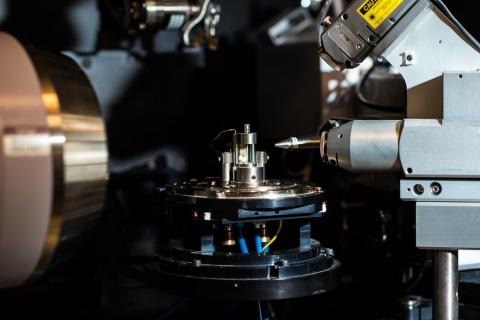Today, the most common methods used for medical device sterilisation are by gaseous ethylene oxide and by electron beam or gamma irradiation. With X-ray sterilisation about to enter the market, its material compatibility needs to be assessed at doses typically encountered during a sterilisation...
Filter results
Category
- (-) Data Analytics & Machine Learning (8)
- (-) Materials Science (7)
- (-) Visual Analytics (6)
- (-) Atmospheric Science (4)
- Scientific Discovery (307)
- Biology (198)
- Earth System Science (136)
- Human Health (102)
- Integrative Omics (73)
- Microbiome Science (42)
- Computational Research (23)
- National Security (21)
- Computing & Analytics (14)
- Chemistry (10)
- Energy Resiliency (9)
- Chemical & Biological Signatures Science (5)
- Computational Mathematics & Statistics (5)
- Weapons of Mass Effect (5)
- Coastal Science (4)
- Ecosystem Science (4)
- Renewable Energy (4)
- Data Analytics & Machine Learning (3)
- Plant Science (3)
- Cybersecurity (2)
- Distribution (2)
- Electric Grid Modernization (2)
- Energy Efficiency (2)
- Energy Storage (2)
- Grid Cybersecurity (2)
- Solar Energy (2)
- Bioenergy Technologies (1)
- Computational Mathematics & Statistics (1)
- Grid Analytics (1)
- High-Performance Computing (1)
- Subsurface Science (1)
- Terrestrial Aquatics (1)
- Transportation (1)
- Wind Energy (1)
Content type
Tags
- Type 1 Diabetes (6)
- Autoimmunity (5)
- Machine Learning (5)
- Biomarkers (4)
- Molecular Profiling (4)
- Mass spectrometry-based Omics (3)
- Predictive Modeling (3)
- Alternative Splicing (2)
- Polymer Materials (2)
- Imaging (1)
- Microbeam (1)
- Microscopy (1)
- Omics (1)
- Spectroscopy (1)
- X-Ray Diffraction (1)
- XANES (1)
- XRF (1)
Ionizing radiation has been found to be widely applicable in modifying the structure and properties of polymers, and can be used to tailor the performance of either bulk materials or surfaces. Fifty years of research in polymer radiation chemistry has led to numerous applications of commercial and...
Category
An alternative method is presented for determining the maximum acceptable dose in products irradiated in electron beam processes. When the presentation of an individual product to the radiation field results in a high dose uniformity ratio, this can present a challenge for accurate testing of a...
Category
Scientific advancements in healthcare driven both by technological breakthroughs and an aging and increasingly obese population have lead to a changing medical device market. Complex products and devices are being developed to meet the demands of leading edge medical procedures.Specialized materials...
Category
The literature on the effects of radiation on the properties of various polymers and composites has been briefly reviewed for the purpose of identifying polymeric materials that could be irradiated to improve their performance. Radiation treatment of polymers may lead to cross-linking or chain...
Category
Category
Dr. Gao obtained her Ph.D degree in Chemistry from institute of chemistry, Chinese Academy of Science. His Ph.D research focused on multiscale modeling of morphology and properties of polymeric materials, polymer processing and unveiling the process–properties relationships. (atomic to coarse...
Category
The Human Islet Research Network (HIRN) is a large consortia with many research projects focused on understanding how beta cells are lost in type 1 diabetics (T1D) with a goal of finding how to protect against or replace the loss of functional beta cells. The consortia has multiple branches of...
Datasets
0
The Environmental Determinants of Diabetes in the Young (TEDDY) study is searching for factors influencing the development of type 1 diabetes (T1D) in children. Research has shown that there are certain genes that correlate to higher risk of developing T1D, but not all children with these genes...
Datasets
1
The Diabetes Autoimmunity Study in the Young (DAISY) seeks to find environmental factors that can trigger the development of type 1 diabetes (T1D) in children. DAISY follows children with high-risk of developing T1D based on family history or genetic markers. Genes, diets, infections, and...
Datasets
1
Machine learning is a core technology that is rapidly advancing within type 1 diabetes (T1D) research. Our Human Islet Research Network (HIRN) grant is studying early cellular response initiating β cell stress in T1D through the generation of heterogenous low- and high-throughput molecular...
Datasets
3
Rigaku Rapid II Microbeam is one of the most versatile micro-diffraction XRD system in materials analysis, using advanced imaging plate technology for measuring diffraction patterns and diffuse scattering from a wide range of materials. The RAPID™ II Curved Detector X-Ray Diffraction (XRD) System's...
Category
Stanford Synchrotron Radiation Lightsource Experimental Station 14-3b is a bending magnet side station dedicated to X-Ray Imaging and Micro X-Ray Absorption Spectroscopy of biological, biomedical, materials, and geological samples. Station 14-3b is equipped with specialized instrumentation for XRF...
Category
Comprehensive assessment of climate datasets created by statistical or dynamical models is important for effectively communicating model projection and associated uncertainty to stakeholders and decision-makers. The Department of Energy FACETS project aims to foster such communication through...









